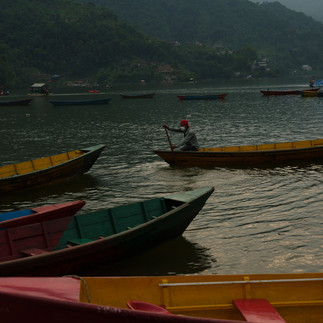Namasthe Nepal - Part II
- Anushka Eranga
- Jul 15, 2024
- 4 min read
Planning a photography trip can be both exciting and overwhelming, especially when you’re visiting a place as visually stunning as Nepal. Here’s how I went about planning my 7-day journey, along with my experience using the Fujifilm GFX50SII, a medium format mirrorless camera that completely changed my perspective on photography.

Planning the Itinerary
Research and Inspiration:I started by searching for #TravelNepal on Instagram to get a sense of the most photogenic locations. I saved images that resonated with me and created a collection. Some photos didn’t have clear location tags, so I reached out to the photographers directly. Most of them were incredibly helpful and even shared the exact GPS coordinates of the spots. This step was crucial in narrowing down my options.
Shortlisting Locations:Based on the research, I shortlisted 10 locations I wanted to shoot within 6 days. I also kept one day free to explore Kathmandu for street photography. However, after mapping out the locations on Google Maps, I realized it would be too ambitious to cover all 10 spots. I eventually limited it to 6 locations to ensure I had enough time to fully experience and photograph each place.
Consulting a Local Guide:A friend who had previously traveled to Nepal connected me with a local travel guide. This guide was instrumental in helping me fine-tune my itinerary, especially in terms of timing and logistics. If you’re planning a photography or hiking trip to Nepal, I highly recommend working with a local guide. (I’ll share his contact details at the end of this post.)
Final Itinerary:My 7-day journey looked like this:
Day 1-2: Kathmandu (street photography and cultural sites)
Day 3: Ghandruk (scenic mountain views and traditional villages)
Day 4: Australian Camp (stunning sunrise and sunset spots)
Day 5-6: Pokhara (lakes, mountains, and serene landscapes)
Day 7: Return to Kathmandu
I won’t go into detail about each location because everyone’s photography interests are different. I recommend doing your own research to find places that align with your style.

My Experience with the Fujifilm GFX50SII
As a long-time Sony user (I’ve been affiliated with Sony Alpha as an Ambassador for Sri Lanka from 2017-2021), I was curious about Fujifilm’s reputation for exceptional color science. Last year, after moving back to Dubai, I decided to give Fujifilm a try. Coincidentally, Fujifilm Middle East reached out to me and provided the GFX50SII for testing. Here’s what I thought:

Specs and Benefits
Medium Format Sensor:The GFX50SII features a 51.4MP medium format sensor, which delivers incredible detail and dynamic range. The larger sensor allows for stunning image quality, especially in landscapes and portraits. The level of detail in my Nepal photos was breathtaking, and the colors were rich and true to life.
Color Science:Fujifilm’s color reproduction is as good as everyone says. The JPEGs straight out of the camera are stunning, with natural skin tones and vibrant landscapes. I found myself relying less on post-processing, which saved me a lot of time.
Build and Ergonomics:The camera is well-built and weather-sealed, making it suitable for outdoor photography in challenging conditions. The grip is comfortable, and the controls are intuitive, though it took me a little time to adjust coming from Sony’s system.
Image Stabilization:The in-body image stabilization (IBIS) is a game-changer, especially for handheld shooting in low light. I was able to capture sharp images even at slower shutter speeds, which was particularly useful during sunrise and sunset shoots.
Lens Ecosystem:Fujifilm’s GF lenses are exceptional. I used the GF 20-35mm f/4 , GF 35-70mm and GF 80mm f/1.7 during my trip, and both delivered outstanding sharpness and clarity. The 80mm f/1.7, in particular, was perfect for portraits and low-light scenarios.

Limitations
Size and Weight:The GFX50SII is larger and heavier than most full-frame mirrorless cameras. While this wasn’t a dealbreaker for me, it’s something to consider if you’re used to a more compact setup.
Autofocus Speed:While the autofocus is accurate, it’s not as fast as Sony’s latest systems. This can be a limitation for fast-paced photography, such as wildlife or sports. However, for landscapes and portraits, it performed admirably.
Battery Life:The battery life is decent but not exceptional. I carried two extra batteries to ensure I didn’t run out of power during long shooting days.
Price:The GFX50SII and its lenses are a significant investment. While the image quality justifies the cost, it’s not a camera for casual photographers or those on a tight budget.

Final Thoughts
The Fujifilm GFX50SII is a powerhouse for photographers who prioritize image quality and color accuracy. It’s particularly well-suited for landscape, portrait, and studio work. While it has some limitations, such as size and autofocus speed, the benefits far outweigh them for the right user.
As for my Nepal trip, the combination of careful planning and the right gear made it an unforgettable experience. If you’re planning a similar journey, take the time to research, connect with locals, and choose equipment that aligns with your creative vision.
Happy Shooting!



















Comments